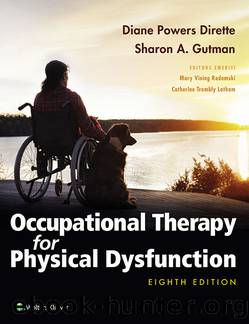Occupational Therapy for Physical Dysfunction by Diane Dirette

Author:Diane Dirette [Dirette, Diane]
Language: eng
Format: azw3
Publisher: Wolters Kluwer Health
Published: 2019-12-17T00:00:00+00:00
Use of Adaptive Equipment or Altering the Task Environment
Use pillows and wedges to assist with positioning during sexual activity.
Use bedrails or overhead trapezes to reposition self in bed.
Low Endurance and Fatigue
Endurance is the ability to sustain physical activity over time. General endurance is a reflection of cardiopulmonary function and overall fitness. Fatigue is not simply low endurance, but a subjective experience of feeling tired or exhausted.22 Fatigue is multidimensional and includes cognitive, behavioral, and emotional components,23 as well as physical factors. A person with low endurance and fatigue may experience difficulty initiating or completing ADLs. Therapists should understand the importance of assessing and monitoring endurance and fatigue during ADL performance such as heart rate (HR)/vitals, metabolic equivalent for task (MET) levels, number or repetitions over a period of time, and scales of perceived exertion. A compendium of physical activities based on MET levels is available in Chapter 40; however, this should always be used in combination with monitoring vital signs.24 Therapists should also be aware of precautions and contraindications when performing ADLs for persons with low endurance and fatigue such as holding oneâs breath during ADLs; isometric contractions for clients with active cardiac histories; significant changes in blood pressure, O2 rate, and HR (>20 beats over resting HR); shortness of breath (dyspnea); and angina. When determining ADL interventions for clients with low endurance and fatigue, therapists should carefully consider the client, the activity, and the environment in which the ADL will be performed.25 Modification techniques and use of adaptive equipment to enhance ADLs for clients with low endurance and fatigue should include energy conservation techniques, as outlined in the subsequent sections.
Bed Mobility
Modification of Technique
Preplan: Prepare the surface to which the patient will transfer and/or the ambulatory device needed.
Perform bed mobility tasks in steps and take breaks.
Supine to sit: Log roll independently or, depending on low endurance level, use assistance of one or two persons (see Weakness).
Bed mobility techniques for weakness apply to clients with low endurance and fatigue.
Download
This site does not store any files on its server. We only index and link to content provided by other sites. Please contact the content providers to delete copyright contents if any and email us, we'll remove relevant links or contents immediately.
Spare by Prince Harry The Duke of Sussex(5061)
Machine Learning at Scale with H2O by Gregory Keys | David Whiting(4133)
Fairy Tale by Stephen King(3205)
Will by Will Smith(2778)
Hooked: A Dark, Contemporary Romance (Never After Series) by Emily McIntire(2488)
The Bullet Journal Method by Ryder Carroll(2465)
Rationality by Steven Pinker(2283)
It Starts With Us (It Ends with Us #2) by Colleen Hoover(2183)
Can't Hurt Me: Master Your Mind and Defy the Odds - Clean Edition by David Goggins(2180)
Friends, Lovers, and the Big Terrible Thing by Matthew Perry(2107)
The Becoming by Nora Roberts(2073)
Love on the Brain by Ali Hazelwood(1946)
The Strength In Our Scars by Bianca Sparacino(1771)
HBR's 10 Must Reads 2022 by Harvard Business Review(1769)
A Short History of War by Jeremy Black(1749)
Leviathan Falls (The Expanse Book 9) by James S. A. Corey(1640)
515945210 by Unknown(1589)
A Game of Thrones (The Illustrated Edition) by George R. R. Martin(1572)
Bewilderment by Richard Powers(1525)
